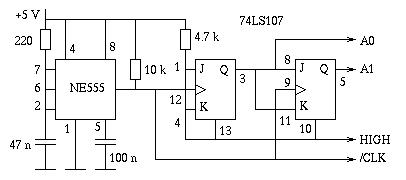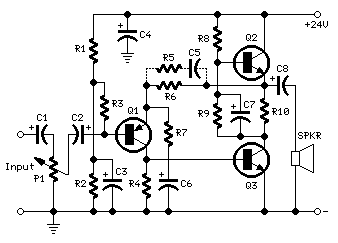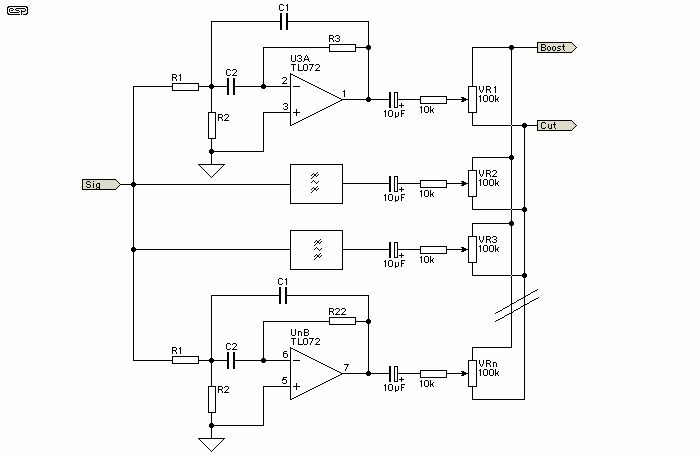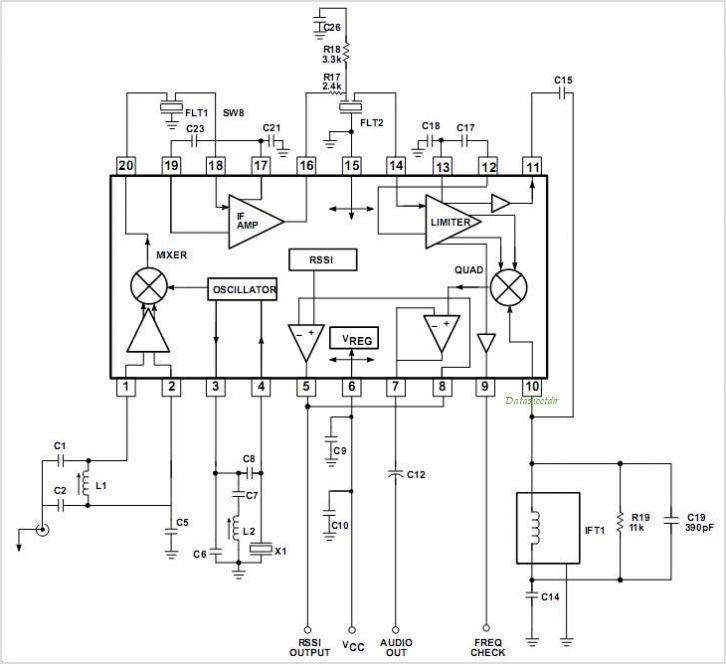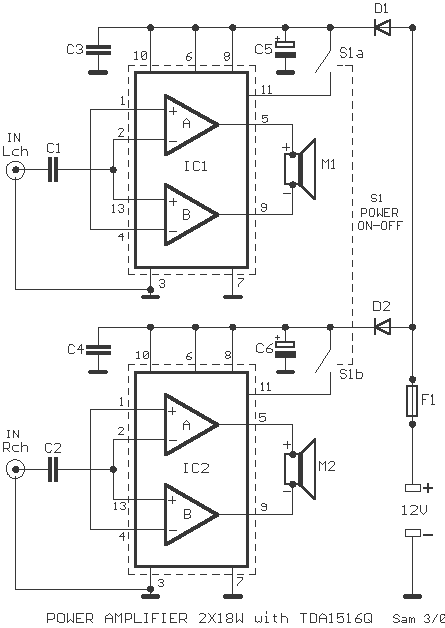
4 Channel Portable Audio Mixer
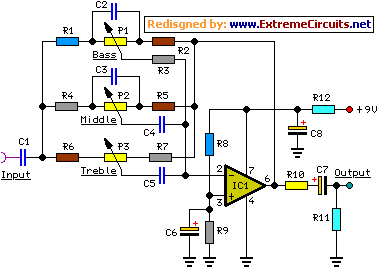
The objective of this project was to design a compact portable mixer powered by a 9V PP3 battery, while ensuring high-quality performance. The mixer consists of three primary modules, which can be customized in quantity and arrangement to meet individual preferences. The three main modules are: Input Amplifier Module: a low-noise circuit featuring a variable voltage gain (10 - 100) preset, primarily designed for high-quality microphone input, but also suitable for low-level line input. Tone Control Module: a three-band (Bass, Middle, Treble) tone control circuit that provides unity gain when its controls are set to a flat frequency response. This module can be placed after one or more Input Amplifier Modules and/or after the Main Mixer Amplifiers. The accompanying block diagram illustrates the entire mixer configuration, which includes four Input Amplifier Modules followed by four switchable Tone Control Modules, one stereo line input, four mono main faders, one stereo dual-ganged main fader, four pan-pots, a stereo Main Mixer Amplifier Module, and two additional switchable Tone Control Modules for each channel, positioned before the main left and right outputs. This layout is flexible and can be rearranged according to individual needs. Notably, the design achieves a complete stereo mixer that consumes less than 6mA of current. The fundamental circuit arrangement is based on the classic Quad magnetic pick-up cartridge module, modified to accommodate microphone input and a single-rail low voltage supply. The low-noise, fully symmetrical two-transistor head amplifier configuration allows for the use of a standard FET input Op-Amp as the second gain stage, even for very sensitive microphone inputs. The amplifier's voltage gain can be adjusted via R9 from 10 to 100, corresponding to 20 to 40dB. The schematic is presented as a stereo unit to clearly depict the input main fader and pan-pot connections. The TL062 chip contains two TL061 op-amps within the same 8-pin package and is configured as two virtual-earth mixer amplifiers with a voltage gain of approximately 4, compensating for losses incurred in the passive pan-pot circuitry. Therefore, the total voltage gain is 1. The components must be connected as shown in the circuit diagram, linking R3 and R4 to pin #2 and pin #6 of IC1 for the right and left channels, respectively. These pins on IC1 serve as the "virtual-earth mixing points" and can sum multiple channels. Additional components include: one main on-off SPST switch, a pilot light LED with a 2K2 1/4W series resistor, DPDT switches to enable or bypass the Tone Control Modules as depicted in the block diagram, preferred input and output connectors, a stereo dual-gang 100K potentiometer to control the stereo line input, a battery clip, a PP3 9V battery, and knobs.
The design of this portable mixer emphasizes modularity and adaptability, allowing users to configure the system to their specific requirements. Each Input Amplifier Module is designed to minimize noise, enhancing the overall audio quality. The variable gain feature allows for precise control over the input signal level, accommodating various microphone types and line-level sources. The Tone Control Module's three-band equalization enables users to tailor the audio output to their preferences, ensuring clarity and balance across different frequency ranges.
The mixer’s power consumption is remarkably low, making it suitable for battery-operated applications. This efficiency is especially beneficial for mobile setups, where power availability may be limited. The integration of the TL062 op-amp not only simplifies the design by reducing the number of components but also enhances performance through its dual-channel capabilities.
In terms of connectivity, the inclusion of various input and output options ensures compatibility with a wide range of audio equipment, facilitating seamless integration into existing setups. The use of a dual-gang potentiometer for the stereo line input allows for synchronized control of both channels, providing a user-friendly interface for volume adjustments.
Overall, this portable mixer design represents a sophisticated solution for audio mixing needs, combining high-quality performance with flexibility and low power consumption, making it an excellent choice for both amateur and professional applications.The target of this project was the design of a small portable mixer supplied by a 9V PP3 battery, keeping high quality performance. The mixer is formed assembling three main modules that can be varied in number and/or disposition to suit everyone needs.
The three main modules are: Input Amplifier Module: a low noise circuit equipped with a variabl e voltage-gain (10 - 100) preset, primarily intended as high quality microphone input, also suitable for low-level line input. Tone Control Module: a three-band (Bass, Middle, Treble) tone control circuit providing unity-gain when its controls are set to flat frequency response.
It can be inserted after one or more Input Amplifier Modules and/or after the Main Mixer Amplifiers. The image below shows a Block diagram of the entire mixer featuring four Input Amplifier Modules followed by four in-out switchable Tone Control Modules, one stereo Line input, four mono Main Faders, one stereo dual-ganged Main Fader, four Pan-Pots, a stereo Main Mixer Amplifier Module and two further Tone Control Modules switchable in and out for each channel, inserted before the main Left and Right outputs. Obviously this layout can be rearranged at everyone wish. An astonishing feature of this design lies in the fact that a complete stereo mixer as shown below in the Block diagram draws less than 6mA current!
The basic arrangement of this circuit is derived from the old Quad magnetic pick-up cartridge module. The circuit was rearranged to cope with microphone input and a single-rail low voltage supply. This low-noise, fully symmetrical, two-transistor head amplifier layout, allows the use of a normal FET input Op-Amp as the second gain stage, even for very sensitive microphone inputs.
The voltage-gain of this amplifier can be varied by means of R9 from 10 to 100, i. e. 20 to 40dB. The schematic of this circuit is drawn as a stereo unit to better show the input Main Fader and Pan-Pot connections. The TL062 chip contains two TL061 op-amps into the same 8 pin case and is wired as two virtual-earth mixer amplifiers having a voltage gain of about 4, to compensate for losses introduced in the passive Pan-Pot circuitry.
Therefore, total voltage-gain is 1. These parts must be wired as shown in the above circuit diagram, connecting R3 and R4 to pin #2 and pin #6 of IC1 for Right and Left channel respectively. These IC1 pins are the "virtual-earth mixing points" and can sum together a great number of channels.
To parts listed above should be added: one Main on-off SPST switch, a LED used as pilot-light with its dropping 2K2 1/4W series-resistor, DPDT switches to enable or omit Tone Control Modules as shown in the Block diagram, input and output connectors of the type preferred, one stereo dual-gang 100K potentiometer to fade the Stereo Line Input as shown in the Block diagram, battery clip, PP3 9V battery, knobs etc. 🔗 External reference
The design of this portable mixer emphasizes modularity and adaptability, allowing users to configure the system to their specific requirements. Each Input Amplifier Module is designed to minimize noise, enhancing the overall audio quality. The variable gain feature allows for precise control over the input signal level, accommodating various microphone types and line-level sources. The Tone Control Module's three-band equalization enables users to tailor the audio output to their preferences, ensuring clarity and balance across different frequency ranges.
The mixer’s power consumption is remarkably low, making it suitable for battery-operated applications. This efficiency is especially beneficial for mobile setups, where power availability may be limited. The integration of the TL062 op-amp not only simplifies the design by reducing the number of components but also enhances performance through its dual-channel capabilities.
In terms of connectivity, the inclusion of various input and output options ensures compatibility with a wide range of audio equipment, facilitating seamless integration into existing setups. The use of a dual-gang potentiometer for the stereo line input allows for synchronized control of both channels, providing a user-friendly interface for volume adjustments.
Overall, this portable mixer design represents a sophisticated solution for audio mixing needs, combining high-quality performance with flexibility and low power consumption, making it an excellent choice for both amateur and professional applications.The target of this project was the design of a small portable mixer supplied by a 9V PP3 battery, keeping high quality performance. The mixer is formed assembling three main modules that can be varied in number and/or disposition to suit everyone needs.
The three main modules are: Input Amplifier Module: a low noise circuit equipped with a variabl e voltage-gain (10 - 100) preset, primarily intended as high quality microphone input, also suitable for low-level line input. Tone Control Module: a three-band (Bass, Middle, Treble) tone control circuit providing unity-gain when its controls are set to flat frequency response.
It can be inserted after one or more Input Amplifier Modules and/or after the Main Mixer Amplifiers. The image below shows a Block diagram of the entire mixer featuring four Input Amplifier Modules followed by four in-out switchable Tone Control Modules, one stereo Line input, four mono Main Faders, one stereo dual-ganged Main Fader, four Pan-Pots, a stereo Main Mixer Amplifier Module and two further Tone Control Modules switchable in and out for each channel, inserted before the main Left and Right outputs. Obviously this layout can be rearranged at everyone wish. An astonishing feature of this design lies in the fact that a complete stereo mixer as shown below in the Block diagram draws less than 6mA current!
The basic arrangement of this circuit is derived from the old Quad magnetic pick-up cartridge module. The circuit was rearranged to cope with microphone input and a single-rail low voltage supply. This low-noise, fully symmetrical, two-transistor head amplifier layout, allows the use of a normal FET input Op-Amp as the second gain stage, even for very sensitive microphone inputs.
The voltage-gain of this amplifier can be varied by means of R9 from 10 to 100, i. e. 20 to 40dB. The schematic of this circuit is drawn as a stereo unit to better show the input Main Fader and Pan-Pot connections. The TL062 chip contains two TL061 op-amps into the same 8 pin case and is wired as two virtual-earth mixer amplifiers having a voltage gain of about 4, to compensate for losses introduced in the passive Pan-Pot circuitry.
Therefore, total voltage-gain is 1. These parts must be wired as shown in the above circuit diagram, connecting R3 and R4 to pin #2 and pin #6 of IC1 for Right and Left channel respectively. These IC1 pins are the "virtual-earth mixing points" and can sum together a great number of channels.
To parts listed above should be added: one Main on-off SPST switch, a LED used as pilot-light with its dropping 2K2 1/4W series-resistor, DPDT switches to enable or omit Tone Control Modules as shown in the Block diagram, input and output connectors of the type preferred, one stereo dual-gang 100K potentiometer to fade the Stereo Line Input as shown in the Block diagram, battery clip, PP3 9V battery, knobs etc. 🔗 External reference
Warning: include(partials/cookie-banner.php): Failed to open stream: Permission denied in /var/www/html/nextgr/view-circuit.php on line 713
Warning: include(): Failed opening 'partials/cookie-banner.php' for inclusion (include_path='.:/usr/share/php') in /var/www/html/nextgr/view-circuit.php on line 713
